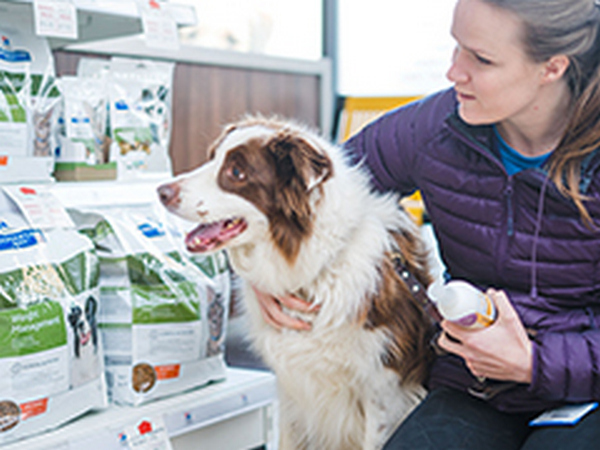Allergies in dogs - Signs, symptoms and treatment
Understanding allergies in dogs can be quite a challenge. Unlike us, our pets can't verbally express what's troubling them. This means it's crucial for us, alongside our vets, to identify and address what’s causing these allergic reactions.
If you suspect your dog might be experiencing allergies or you just want to be prepared, this guide is for you.
Brief summary
- Dogs can't tell us what's wrong, making it crucial for us to recognise and address potential allergens
- From skin irritations and digestive issues to behavioural changes, allergies manifest in various ways
- A significant number of dogs get allergies, and some breeds are more likely to develop them
- Dogs can be allergic to foods, environmental factors, contact substances, and more
- Proper diagnosis, tailored treatments, and preventive measures are key to managing and alleviating allergy symptoms
What are dog allergies?
Just like humans, dogs can be allergic to lots of substances, ranging from certain foods to pollen or dust. An allergy happens when your dog’s immune system responds inappropriately to a substance (the allergen) which dogs normally wouldn’t react to. These allergies can manifest in various ways, from skin irritations and digestive issues to more severe respiratory problems. But, remember, dog allergies can be complex and are often misunderstood.
Common symptoms of allergies in dogs
Skin issues
Redness, itching, swelling, and hives are typical signs of skin irritation caused by allergies. You may notice your dog scratching or biting at certain areas, licking themselves more, or rubbing their body along the furniture or floor.
Digestive problems
Food allergies can lead to gastrointestinal issues such as vomiting, diarrhoea, or excessive gas.
Respiratory symptoms
Sneezing, coughing, or wheezing may indicate an allergic reaction to airborne substances.
Eye irritation
Watery, red, or itchy eyes can be a sign of allergies.
Ear infections
Chronic or recurrent ear infections may be linked to underlying allergies.
Spotting the signs of dog allergies
Figuring out dog allergies can be a bit like piecing together a puzzle. Here's a quick rundown to help you spot what might be bugging your dog:
- Food allergies? These can give your dog gastrointestinal troubles, itchy skin, or even ear infections.
- Bitten by a flea or bug? This usually means super itchy skin, red spots, and some swelling where they got bitten.
- Environmental allergies (like pollen)? Depending on the season, your dog might sneeze more, scratch a lot, or get rashes. Watch out for issues on their paws, face, or tummy.
- Contact allergies? These appear where your dog touched something they're allergic to, like a cleaning fluid or plant.
How common are allergies in dogs?
Around 10% to 15% of dogs are believed to suffer from some form of allergy, although this figure may vary depending on age, breed, and location. Food allergies account for around 10% of allergies in dogs, flea bite allergies for about 40%, and atopic dermatitis (environmental allergies) for the remaining 50%.
Have any studies into dog allergies been carried out?
Research from the University of Nottingham's School of Veterinary Medicine has found a direct connection between canine atopic dermatitis (cAD), and problem behaviour. The study looked at 343 dogs with cAD and 552 healthy dogs. The team found that the worse the itching got, the more problem behaviours like chewing and hyperactivity were reported. The study suggests that treating this skin condition should include managing any stress that might be making the condition worse.
Another study looked at how allergen-specific immunotherapy, a treatment where dogs get a mix of allergens to help them cope better, affects their quality of life compared to other treatments. Dogs treated this way were less fussy at meal times and made life more comfortable for their owners too.
But it's not just the dogs who benefited. Their owners found they could enjoy life more, from going on walks to even saving money on vet bills. They also felt a lot less stressed and had better relationships with family and friends.
Are certain breeds more likely to have allergies?
While any dog can develop allergies, some breeds are genetically predisposed and therefore more likely to develop allergies. These include:
- West Highland White Terrier
- Golden and Labrador Retrievers
- Boxers
- English and French Bulldogs
- Pugs
- Lhasa Apso
- Wirehaired Fox Terrier
Are dogs more prone to allergies depending on where they live?
Different areas of the world have different plants, insects, and weather conditions that can influence common allergies. For example, in areas with distinct seasonal changes, environmental allergies (such as to pollens and grasses) may be more common during certain times of the year. Meanwhile, dogs living in towns and cities might face more respiratory allergies, while those in rural areas are potentially more likely to suffer contact allergies related to plants and outdoor exposure.
Common allergens in dogs
Allergens from food and the environment can affect dogs. It’s useful to be able to recognise these allergens and how to reduce your dog’s exposure to them. This table lists common dog allergens, sorted by type with examples:
| Common Allergens in Dogs | |
|---|---|
| Food Allergens | Beef Dairy Chicken Soy Wheat Eggs Fish |
| Environmental Allergens | Pollen (from trees, grasses, and weeds) Dust mites Mould spores Animal dander (from other pets) |
| Contact Allergens | Flea saliva (Flea Allergy Dermatitis) Cleaning products Synthetic fibres (in carpets, bedding) Certain plants |
| Inhalant Allergens | Smoke Perfumes Airborne chemicals |
When to consult a vet
Always contact your vet if your dog is displaying unusual symptoms, such as excessive scratching, redness, swelling, digestive issues, or changes in behaviour. It’s also best to consult your vet before significantly changing your dog's routine or diet.
Diagnosing allergies in dogs
Figuring out if a dog has allergies can be tricky but it's really important. It helps you and your vet find out what's causing the allergic symptoms and how to treat them. If your dog has allergy issues, it's important to know about the role of skin and blood tests and why they matter.
Importance of proper diagnosis
- Proper diagnosis helps identify the specific allergens responsible for the symptoms, allowing for targeted treatment
- Without accurate diagnosis, unnecessary or ineffective treatments may be used, leading to ongoing discomfort for your dog
- Understanding the underlying cause of allergies enables long-term management strategies, improving the dog's quality of life
What will happen when you visit your vet?
It’s likely your vet will ask about your dog’s symptoms, diet, where they live and exercise, and whether they've been around things that might cause an allergic reaction. They'll also discuss your pet’s medical history and ask about any allergy problems your dog may have had in the past, such as skin conditions, ear infections, or gastrointestinal issues.
Following this, it’s likely they’ll carry out a thorough physical examination. They’ll assess your dog’s general health, and examine any specific problem areas such as sore patches of skin. Your vet may then recommend further testing, such as skin scrapings or biopsies, blood tests, a food trial or allergy testing.
Are there allergy tests for dogs?
Yes, dogs can get allergy tests to find out what's causing their symptoms. These tests help figure out and treat dog allergies. It's important for dog owners who suspect their dog has an allergy to know about these tests, how they work, and what they can and can't do. There are two main ways of dog allergy testing: skin testing and blood testing.
Skin testing
Skin testing is where tiny amounts of potential allergens are applied to your dog's skin while your vet monitors them for any reactions. Skin testing is crucial in identifying specific substances that may be causing your pet discomfort or health issues.
Your vet will shave some of your dog before lightly pricking or scratching the skin so the allergens can enter the bloodstream. While it's not considered painful, skin testing can cause some discomfort. Most dogs will handle this pricking or scratching well, and the potential discomfort is no different from a human getting a small scratch or mild pinch.
However, if your dog has a positive reaction to an allergen, it can cause itching and inflammation where the allergen was tested. This reaction is usually temporary and subsides after the area is cleaned.
Blood testing
Blood tests can detect antibodies in the immune system which can help uncover what your dog might be allergic to. The vet will shave a small spot and take some blood, usually from the front of the neckk. The results of this test combined with your dog's medical history can help your vet figure out the best treatment plan.
Common treatments for dog allergies
Helping dogs with allergies can be tricky because each dog and each allergy is different. It's not just about giving medicine, it's also about understanding what's causing the allergy and keeping an eye on the dog over time. There’s no one-size-fits-all approach for the treatment of allergies.
Medication
There are lots of options for medications which can manage your dog’s immune reaction to allergens, reduce symptoms and improve your dog’s comfort. Your vet might suggest different treatments based on how bad the allergy is. They might prescribe injectable medication to alter your dog’s immune response to allergens, oral tablets like antihistamines or corticosteroids to reduce itching, or topical treatments such as shampoos to improve skin health and manage itching and infection. They may discuss immunotherapy: a treatment where the dog is given small amounts of what they're allergic to, so they build up a tolerance over time.
Role of diet in managing allergies

Diet plays a crucial role in managing your dog's allergies. Some dogs may be allergic to certain foods, and identifying and eliminating these from your dog's diet can significantly reduce allergy symptoms. A balanced diet rich in essential nutrients can boost your dog's overall immune health and skin barrier, making them less susceptible to allergies.
Regular vet check-ups
Regular vet check-ups are also essential for managing your dog's allergies. The vet can monitor your dog's condition, adjust treatments as necessary, and advise on managing symptoms at home.
Preventing allergies in dogs
While it's not possible to prevent allergies, you can take steps to reduce your dog's exposure to allergens. Here are some simple tips for this:
Regular cleaning
Regularly clean your home to remove potential allergens such as dust mites and pollens brought in from outside. This includes vacuuming carpets, washing bedding, and cleaning surfaces. A vacuum with a HEPA filter can be particularly effective as it can capture small allergen particles.
Air purifiers
Using air purifiers, particularly those with HEPA filters, can help remove allergens from the air in your home, reducing your dog's exposure.
Hypoallergenic products
If your dog is sensitive to topical products, such as shampoos, speak to your vet about suitable alternatives.
Specific allergies in dogs
What’s a flea or insect allergy?
Flea or insect bite allergy, specifically known as Flea Allergy Dermatitis (FAD), is a common and often distressing condition in dogs. Flea or insect bite allergy occurs when your dog is hypersensitive to the saliva of fleas or other biting insects. Even a single bite can trigger an intense allergic reaction in susceptible dogs.

Symptoms include:
- Affected dogs often exhibit severe itching, especially around the bite area
- The skin around the bite may become red, swollen, and inflamed
- Continuous scratching can lead to open sores, scabs, and secondary skin infections
- Chronic scratching may result in hair loss in the affected area
Treatment
- The cornerstone of treatment is effective flea control, using veterinarian-recommended flea prevention products on the dog and any other pets, and treating the environment to eliminate fleas
- Topical creams or ointments containing corticosteroids or other anti-inflammatory agents may be prescribed to soothe the skin
- In severe cases, oral antihistamines or corticosteroids may be prescribed to control itching and inflammation
- If secondary infections are present, antibiotics may be necessary
- Gentle bathing with hypoallergenic or medicated shampoos can help soothe the skin. Regular grooming can also aid in monitoring and early detection
What is atopic dermatitis (atopy)?
Atopic dermatitis, or atopy, is a skin allergy caused by environmental allergens, such as the likes of pollen, dust mites, moulds, and animal fur. When dogs come into contact with these, their immune system can overreact, causing skin to become inflamed and irritated. Some symptoms can get worse during certain times of the year.
Symptoms include:
- Intense itching, especially around the face, paws, underbelly, and ears
- Redness and inflammation
- Chronic scratching, causing open sores, scabs, and secondary bacterial infections
- Ear Infections
Treatment
- If you know what's causing the allergy, try to keep your dog away from it, like closing windows when there's lots of pollen or wiping them down after walks
- Topical creams or ointments containing corticosteroids or other anti-inflammatory agents can soothe the skin
- Antihistamines or corticosteroids may be prescribed to control itching and inflammation
- Allergen-specific immunotherapy (allergy shots or oral drops) may be used to desensitise the dog to specific allergens over time
- Bathing with hypoallergenic or medicated shampoos can help soothe the skin and remove allergens from the coat
- Omega-3 fatty acid supplements may help improve skin health

Acute allergic reactions in dogs
Acute allergic reactions in dogs are sudden and severe responses to allergens that can be life-threatening if not treated quickly. These reactions happen fast, sometimes within minutes of being exposed to something.
Insect stings (such as bee or wasp stings), certain medications, vaccines, food, or other substances that your dog may be hypersensitive to are all common triggers. These reactions can range from mild to severe, with the most serious known as anaphylaxis, which can be fatal.
Mild to moderate symptoms include:
- Swelling of the face, lips, or ears
- Hives or raised, red, itchy patches on the skin
- Excessive drooling or salivation
- Sudden vomiting or diarrhoea
Severe symptoms (anaphylaxis):
- Difficulty breathing or wheezing
- Pale or blue-tinged gums
- Rapid or weak pulse
- Collapse or loss of consciousness
- Seizures
Treatment
If you observe any signs of an acute allergic reaction, contact your vet immediately. If the reaction is caused by an insect sting and the stinger is visible, try to remove it gently with tweezers without squeezing it and encourage your dog to lie down and stay calm, as stress can make the reaction worse. Your vet may prescribe antihistamines, corticosteroids or epinephrine and may provide intravenous fluids or oxygen therapy.
What are food allergies?
Food allergies in dogs are a common and often challenging condition to manage. A food allergy occurs when your dog's immune system mistakenly identifies a specific food protein as harmful, triggering an allergic reaction.
Symptoms include:
- Itching
- Redness
- Hives
- Chronic ear infections
- Vomiting
- Diarrhoea
- Changes in appetite
Treatment options can include:
Elimination diet
The process of identifying a dog's food allergy involves feeding the dog a special diet that excludes common allergens, often using new or specially-treated proteins. Over a period of eight to 12 weeks various foods are gradually reintroduced into the diet to pinpoint the specific cause of the allergy. The outcome of this method helps in customising the dog's diet to avoid the particular allergen.
Once identified, allergenic food must be completely avoided and your dog will be offered a specialised commercial diet recommended by your vet.
Symptomatic treatment
Your vet may prescribe antihistamines or corticosteroids to control symptoms during the diagnostic process.
Long-term management
It's important to regularly monitor your dog’s diet and stick to the foods your vet recommends.
What are contact allergies?
Contact allergies, also known as contact dermatitis, happen when your dog's skin reacts to something it comes into contact with, triggering an allergic reaction. The immune system's overreaction to these substances causes the skin to become red and sore right where it touched the irritant.
Common triggers can include plants, cleaning products, synthetic fibres in carpets or bedding, rubber, plastics, metals and some topical medications.
Symptoms include:
- Symptoms usually show up in certain areas, like the belly from lying on something irritating or paws from walking on it.
- Intense itching at the contact site
- The affected area may become red, swollen, and inflamed
- Chronic scratching can lead to open sores, scabs, and secondary bacterial infections
Treatment
The main way to treat contact allergies is to figure out what's causing them and then remove it. This might mean changing things like your dog's bedding, their grooming products, or the cleaning products used around the house. Your vet might give special creams or ointments that help calm down the skin. If the allergies are really bad, your vet might give medicine to take by mouth or injection to help stop the itching and swelling.
Washing your dog regularly with special shampoos that are gentle on the skin can help make their skin feel better and get rid of things that might be causing the allergies.

Advice on dog allergies
For expert advice and treatment on dog allergies, contact your local vet.
Find your nearest vet using our Find a Vet page, or speak to a vet online using Video Vets Now.


